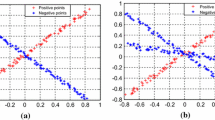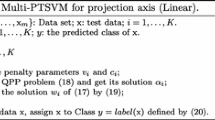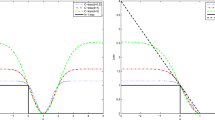Abstract
Traditional projection twin support vector machines (SVMs) ignore the differences between the categories when establishing the objective functions, which would lessen their generalization performance. To solve the issue, an improved projection twin SVM (abbreviated as IPTSVM) is proposed in this paper, which aims to find two projected directions via a single quadratic programming problem. In their respective subspace, the projected sample points belonging to each category are far from those of the other class. Meanwhile, to enhance the performance, the recursive arithmetic seeks for more than one projection directions for each class. Besides, an effective clipping dual coordinate descent model is adopted to solve the dual problem to accelerate the training process. The linear IPTSVM model could be changed into the nonlinear model by using the kernel metric. Furthermore, the multi-label version of IPTSVM model is developed to deal with the multi-label learning problems. Experiments on a set of public datasets show that the IPTSVM model has significant advantages over the other models in terms of generalization performance.






Similar content being viewed by others
References
Vapnik V (1999) An overview of statistical learning theory. IEEE Trans Neural Netw 10(5):988–999
Cortes C, Vapnik V (1995) Support vector networks. Mach Learn 20:273–297
Liu YH, Chen YT (2007) Face recognition using total margin-based adaptive fuzzy support vector machines. IEEE Trans Neural Netw 18(1):178–192
Osuna E, Freund R, Girosi F (1997) Training support vector machines: an application to face detection. In: Proceedings of IEEE computer vision and pattern recognition, Puer to Rico, San Juan, pp 130–136
Joachims T, Ndellec C, Rouveriol C (1998) Text categorization with support vector machines: learning with many relevant features. In: European conference on machine learning No. 10, Chemnitz, Germany, pp 137–142
Trafalis TB, Ince H (2000) Support vector machine for regression and applications to financial forecasting. In: Proceedings of the IEEE-INNS-ENNS international joint conference on IEEE, 6th edn. pp 348–353
Ding SF, Yu JZ, Qi BJ, Huang HJ (2014) An overview on twin support vector machines. Artif Intell Rev 42:245–252
Jayadeva Khemchandani R, Chandra S (2007) Twin support vector machines for pattern classication. IEEE Trans Pattern Anal 29:905–910
Mangasarian OL, Wild EW (2006) Multisurface proximal support vector classification via generalized eigenvalues. IEEE Trans Pattern Anal 28(1):69–74
Ghorai S, Mukherjee A, Dutta PK (2009) Nonparallel plane proximal classifier. Signal Process 89:510–522
Shao YH, Zhang CH, Wang XB, Deng N (2011) Improvements on twin support vector machines. IEEE Trans Neural Netw 22(6):962–968
Peng XJ (2010) A v-twin support vector machine (v-TSVM) classifier and its geometric algorithms. Inf Sci 180:3863–3875
Xu YT, Guo R (2014) An improved ν-twin support vector machine. Appl Intell 41:42–54
Peng XJ, Xu D (2012) Twin Mahalanobis distance-based support vector machines for pattern recognition. Inf Sci 200:22–37
Qi ZQ, Tian YJ, Shi Y (2013) Robust twin support vector machine for pattern classification. Pattern Recognit 46:305–316
Shao YH, Chen WJ, Deng NY (2014) Nonparallel hyperplane support vector machine for binary classification problems. Inf Sci 263:22–35
Zhou XJ, Jiang T (2016) Enhancing least square support vector regression with gradient information. Neural Process Lett 43:65–83
Li JT, Cao YM, Wang YD, Xiao HM (2016) Online learning algorithms for double-weighted least squares twin bounded support vector machines. Neural Process Lett. doi:10.1007/s11063-016-9527-9
Xi XM, Huang XL, Suykens JA, Wang SN (2016) Coordinate descent algorithm for ramp loss linear programming support vector machines. Neural Process Lett 43:887–903
Chen SG, Wu XJ, Zhang RF (2016) A novel twin support vector machine for binary classification problems. Neural Process Lett. doi:10.1007/s11063-016-9495-0
Shao YH, Deng NY, Yang ZM (2012) Least squares recursive projection twin support vector machine for classification. Pattern Recognit 45(6):2299–2307
Shao YH, Chen WJ, Liu LM, Deng NY (2015) Laplacian unit-hyperplane learning from positive and unlabeled examples. Inf Sci 314:152–168
Wang Z, Shao YH, Bai L, Deng NY (2015) Twin support vector machine for clustering. IEEE Trans Neural Netw 26(10):2583–2588
Shao YH, Deng NY, Chen WJ (2013) A proximal classifier with consistency. Knowl Based Syst 49:171–178
Kumar M, Gopal M (2008) Application of smoothing technique on twin support vector machines. Pattern Recognit Lett 29:1842–1848
Chen XB, Yang J, Ye QL, Liang J (2011) Recursive projection twin support vector machine via within-class variance minimization. Pattern Recognit 44:2643–2655
Fung G, Mangasarian OL (2001) Proximal support vector machine classifiers. In: Proceedings of seventh international conference on knowledge and data discovery, San Francisco, pp 77–86
Ye Q, Zhao C, Ye N, Chen Y (2010) Multi-weight vector projection support vector machines. Pattern Recognit Lett 31(13):2006–2011
Shao YH, Wang Z, Chen WJ, Deng NY (2013) A regularization for the projection twin support vector machine. Knowl Based Syst 37:203–210
Kudoh T, Matsumoto Y (2001) Chunking with support vector machines. In: Proceedings of the second meeting of the North American chapter of the association for computational linguistics on language technologies. MIT Press, Cambridge, pp 1–8
Platt J (1999) Fast training of support vector machines using sequential minimal optimization. In: Schölkopf B, Burges CJC, Smola AJ (eds) Advances in Kernel methods-support vector machine. MIT Press, Cambridge, pp 185–208
Joachims T (1999) Making large-scale SVM learning practical. In: Schölkopf B, Burges CJC, Smola AJ (eds) Advances in Kernel methods: support vector machine. MIT Press, Cambridge, pp 169–184
Chang CC, Lin CJ (2001) LIBSVM: a library for support vector machines. http://www.csie.ntu.edu.tw/cjlin
Mavroforakis M, Theodoridis S (2006) A geometric approach to support vector machine (SVM) classification. IEEE Trans on Neural Netw 17(3):671–682
Mangasarian OL, Musicant DR (1999) Successive overrelaxation for support vector machines. IEEE Trans Neural Netw 10(5):1032–1037
Hsieh CJ, Chang KW, Lin CJ (2008) A dual coordinate descent method for large-scale linear SVM. In: Proceedings of the 25th international conference on machine learning, Helsinki, Finland
Peng XJ, Chen DJ, Kong LY (2014) A clipping dual coordinate descent algorithm for solving support vector machines. Knowl Based Syst 71:266–278
Chen WJ, Shao YH, Li CN, Deng NY (2016) MLTSVM: a novel twin support vector machine to multi-label learning. Pattern Recognit 52:61–74
Zhang M, Zhou Z (2014) A review on multi-label learning algorithms. IEEE Trans Knowl Data Eng 26(8):1819–1837
Blake CL, Merz CJ (1998) UCI repository for machine learning databases. http://www.ics.uci.edu/mlearn/MLRepository.html
Musicant DR. (1998) NDC: normally distributed clustered datasets. http://www.cs.wisc.edu/dmi/svm/ndc/
Acknowledgements
This work is supported by ‘the Fundamental Research Funds for the Central Universities’ (2016B02914), National Natural Science Foundation (NNSF) of China (61403122) and Science and Techonology Development Funds of Jiangsu Province (2015030-03).
Author information
Authors and Affiliations
Corresponding author
Ethics declarations
Conflict of interest
We declare that we have not any financial and personal relationships with other people or organizations that can inappropriately influence this work, there is no professional or other personal interest of any nature or kind in any product, service and/or company that could be construed as influencing the position presented in, or the review of, the manuscript entitled ‘Improvement on projection twin support vector machine.’
Rights and permissions
About this article
Cite this article
Xie, X. Improvement on projection twin support vector machine. Neural Comput & Applic 30, 371–387 (2018). https://doi.org/10.1007/s00521-017-3237-8
Received:
Accepted:
Published:
Issue Date:
DOI: https://doi.org/10.1007/s00521-017-3237-8




